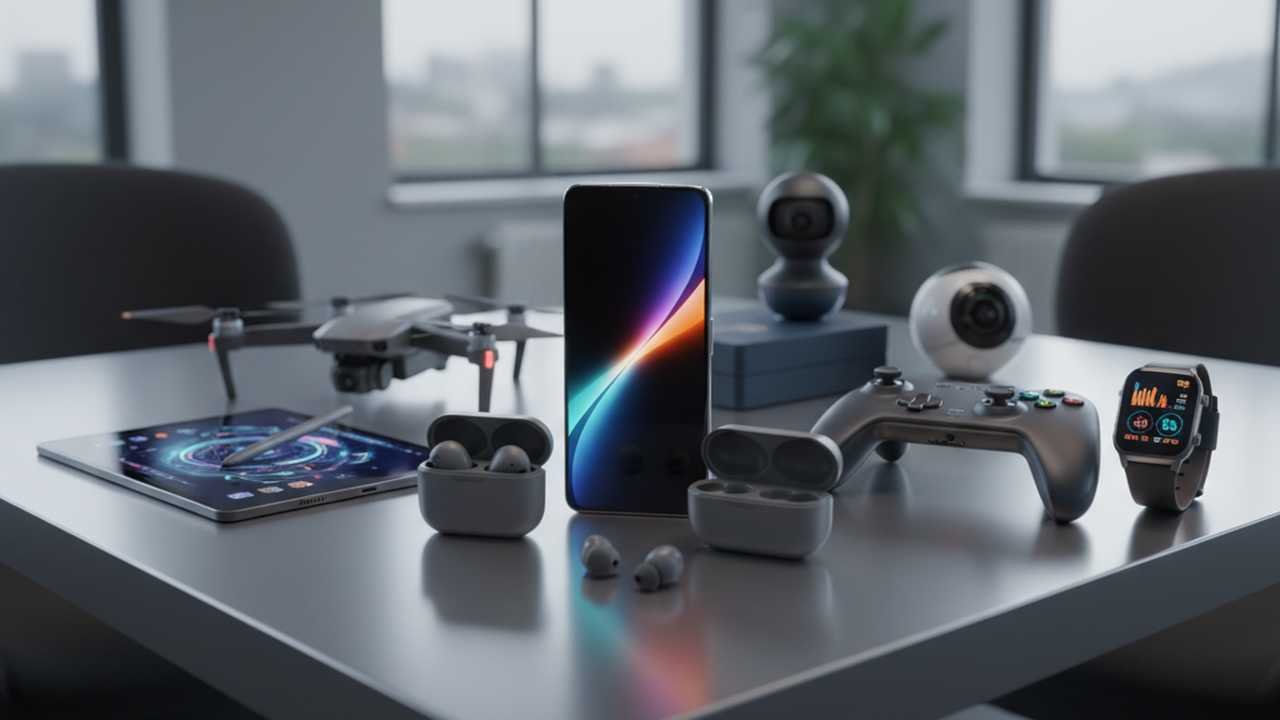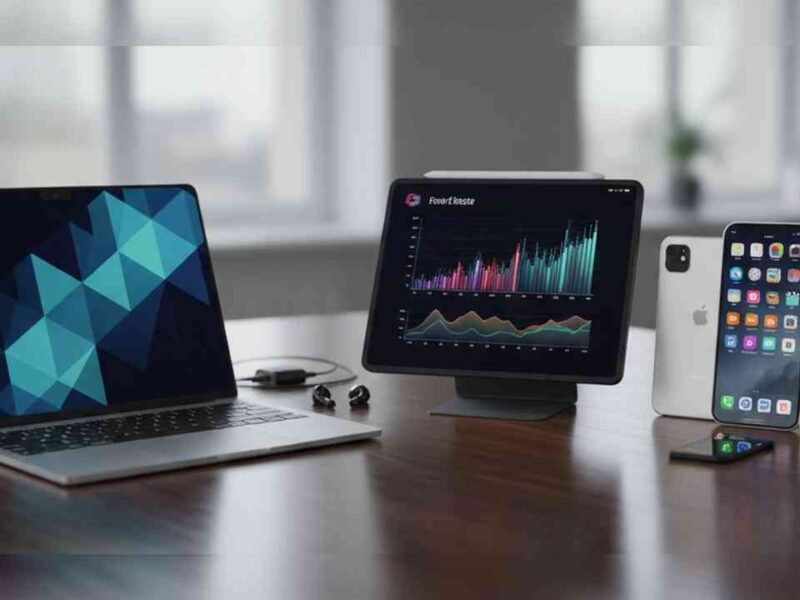In 2025, the world of consumer electronics has undergone a radical transformation, introducing a wave of innovative gadgets that promise to redefine our daily lives. From AI-powered devices to immersive AR experiences, the latest releases are not just products; they are gateways to a smarter, more connected future. If you haven’t yet explored these groundbreaking technologies, you’re already falling behind. The clock is ticking, and the future waits for no one.
The Rise of AI-Powered Gadgets
Artificial Intelligence has transitioned from a buzzword to a tangible force driving innovation in consumer electronics. At CES 2025, numerous devices showcased the potential of AI to enhance user experience. One standout is the Asus ROG Phone 9, equipped with a Snapdragon 8 Elite processor and AI-enhanced gaming features. This smartphone adapts to your gaming habits, optimizing performance in real-time to deliver an unparalleled experience. Such advancements signify a paradigm shift in how we interact with technology, making AI an indispensable part of our daily lives.
Moreover, the integration of AI extends beyond smartphones. Smart home devices now leverage AI to anticipate user needs, adjust settings automatically, and provide personalized experiences. This seamless integration creates an environment where technology not only responds to commands but also learns and adapts to individual preferences, enhancing convenience and efficiency.
Augmented Reality: Blurring the Lines Between Digital and Physical Worlds
Augmented Reality (AR) is no longer confined to niche applications; it’s becoming a mainstream feature in consumer electronics. Devices like the Halliday AI Smart Glasses introduced at CES 2025 offer real-time information overlays, navigation assistance, and immersive gaming experiences. These smart glasses are designed to enhance daily activities, providing users with contextual information without the need to glance at a smartphone screen.
The potential applications of AR are vast. In education, AR can bring complex concepts to life, offering interactive learning experiences that engage students in new ways. In retail, AR enables virtual try-ons, allowing customers to visualize products before making a purchase. As AR technology continues to evolve, its integration into consumer electronics is set to revolutionize various industries, offering immersive and interactive experiences that were once the realm of science fiction.
Wearable Technology: The Next Frontier in Personal Health
Wearable devices have evolved from simple fitness trackers to sophisticated health monitoring systems. The Garmin Instinct 3 Smartwatch introduced at CES 2025 is a prime example, offering features like heart rate monitoring, sleep tracking, and stress level assessments. These devices provide users with real-time insights into their health, empowering them to make informed decisions about their well-being.
Beyond fitness, wearables are now capable of detecting early signs of health issues, such as irregular heart rhythms or sleep apnea. This proactive approach to health monitoring allows for early intervention, potentially preventing serious medical conditions. As wearable technology continues to advance, it holds the promise of revolutionizing personal healthcare, making it more accessible and personalized than ever before.
Smart Home Devices: Creating Intelligent Living Spaces
Smart home technology has progressed beyond basic automation to create intelligent living spaces that anticipate and respond to user needs. Devices like the Ring Alarm Pro Home Security Kit and the SimpliSafe 9pc Outdoor Home Security System offer advanced security features, including motion detection, remote monitoring, and integration with other smart home devices. These systems provide homeowners with peace of mind, knowing that their property is protected by state-of-the-art technology.
Furthermore, smart home devices now offer energy management capabilities, allowing users to monitor and control energy consumption. This not only leads to cost savings but also contributes to environmental sustainability. As smart home technology continues to evolve, it is transforming the way we live, making our homes more secure, efficient, and connected.
Flexible Displays: The Future of Portable Devices
Flexible display technology is paving the way for a new generation of portable devices. The introduction of foldable smartphones and tablets has redefined the concept of portability, allowing users to enjoy the functionality of larger screens without sacrificing convenience. These devices are equipped with flexible OLED displays that can be bent and folded without compromising performance or durability.
The applications of flexible displays extend beyond smartphones. In the automotive industry, flexible displays are being integrated into dashboards and infotainment systems, offering customizable interfaces that enhance user experience. In fashion, designers are exploring the use of flexible displays in clothing and accessories, creating garments that can change color or display information. As flexible display technology continues to advance, it is set to revolutionize various industries, offering new possibilities for design and functionality.
Robotics: Enhancing Everyday Tasks
Robotic technology has made significant strides, leading to the development of devices that assist with everyday tasks. The Beatbot AquaSense 2 is an autonomous pool cleaner that navigates and cleans pools without human intervention. Similarly, the Grillbot is an automatic grill cleaning robot that uses nylon brushes to clean BBQ cooktops, saving time and effort for users.
These advancements in robotics are not limited to household chores. In healthcare, robots are being developed to assist with patient care, offering support in tasks such as mobility assistance and medication delivery. In manufacturing, robots are streamlining production processes, improving efficiency and safety. As robotics technology continues to evolve, it is poised to play a pivotal role in enhancing productivity and quality of life across various sectors.
AI in Consumer Electronics: A Game Changer
The integration of Artificial Intelligence into consumer electronics is not just a trend; it’s a fundamental shift in how devices operate and interact with users. At CES 2025, numerous products showcased the power of AI to enhance functionality and user experience. For instance, Samsung’s new lineup of TVs, including the S95F OLED and QN900F 8K Neo QLED, feature AI-enhanced gamma for improved dark scene visuals and a wireless One Connect box enabled by Wi-Fi 7, offering seamless connectivity and setup.
AI is also being utilized to personalize user experiences. Devices learn from user behavior, adapting settings and features to individual preferences. This level of personalization enhances convenience and satisfaction, as devices become more intuitive and responsive. As AI continues to advance, its integration into consumer electronics will drive innovation, leading to smarter and more efficient devices that cater to the unique needs of users.
Immersive Entertainment: Redefining Media Consumption
Entertainment technology has evolved to offer more immersive and engaging experiences. The LG Smart Instaview Microwave introduced at CES 2025 features an interactive touchscreen and cooking sensors, allowing users to access recipes, control cooking settings, and monitor progress without opening the door. This integration of smart technology into kitchen appliances enhances convenience and efficiency, making cooking a more interactive experience.
In the realm of audio-visual entertainment, advancements in display and sound technology are creating more immersive viewing experiences. Samsung’s new TVs offer improved brightness, enhanced color accuracy, and AI-driven features that adjust settings based on content type. Coupled with advancements in sound technology, such as Dolby Atmos support and AI-enhanced audio, these devices deliver a cinematic experience in the comfort of home. As entertainment technology continues to advance, it is transforming how we consume media, offering experiences that are more immersive and personalized than ever before.
Seamless Connectivity: The Backbone of Smart Devices
As the number of connected devices increases, seamless connectivity becomes crucial. The introduction of Wi-Fi 7 technology is a significant advancement, offering faster speeds, lower latency, and improved reliability. Devices like Samsung’s QN990F 8K Neo QLED TV utilize Wi-Fi 7 to provide seamless streaming and connectivity, ensuring a smooth user experience.
Moreover, the integration of 5G technology is enhancing connectivity for mobile devices, enabling faster download speeds and more reliable connections. This is particularly beneficial for applications such as augmented reality, virtual reality, and cloud gaming, which require high-speed internet access. As connectivity technology continues to evolve, it will support the growing ecosystem of smart devices, ensuring that users can enjoy seamless and uninterrupted experiences.
In conclusion, the consumer electronics landscape in 2025 is characterized by rapid innovation and technological advancements. From AI-powered gadgets to immersive AR experiences, the latest releases are shaping a smarter, more connected future. To stay ahead in this fast-paced industry, it’s essential to stay informed about the latest trends and developments. Don’t miss out on the opportunity to experience these groundbreaking technologies – explore the latest consumer electronics today and embrace the future of innovation.


